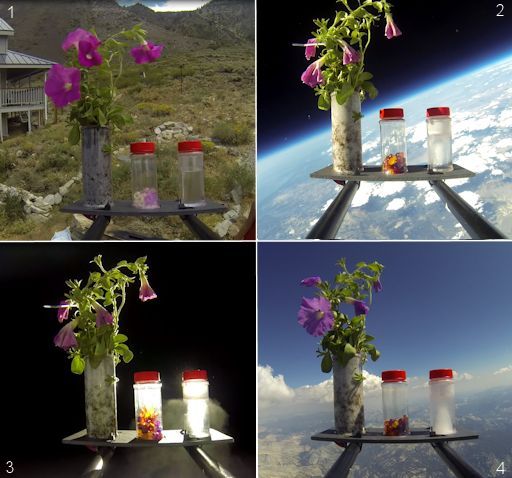When is the best time to see auroras? Where is the best place to go? And how do you photograph them? These questions and more are answered in a new book, Northern Lights - a Guide, by Pal Brekke & Fredrik Broms. | | |
FLATLINED: Solar activity is very low. With no sunspots actively flaring, the sun's x-ray output has flat-lined. NOAA forecasters estimate a 10% chance of M-class solar flares today and no more than a 1% chance of X-flares. Solar flare alerts: text, voice.
PETUNIAS AT THE EDGE OF SPACE: The students of Earth to Sky Calculus have recovered the petunias they sent to the stratosphere last Friday. The flowers left Earth July 19th onboard a helium research balloon, ascended to 110,570 feet, then parachuted back to Earth on the same day. These four screenshots, culled from more than 2 hours of high-definition video, summarizes what happened:

(1) The flowers were pink and alert when they left Earth. (2) An hour later, in the stratosphere, the flowers appear limp and wilted, but they were not. Actually, the flowers were frozen. The petals were bent downward by onrushing wind during the ascent, and they froze in place as the petunias passed through the tropopause where the temperature was -63 C. (3) You can see that the flowers were frozen stiff because when the balloon exploded, they did not move at all. (4) Finally, as the payload parachuted back to Earth the flowers thawed and turned deep purple.
The petunias were just one of several experiments flown to the stratosphere on July 19th during Cassini's historic photo-shoot of Earth through the rings of Saturn. Other items on board were selected competitively from more than 1056 entries suggested by Spaceweather.com readers. First place winners of the competition received free telescopes from Explore Scientific.
For updates about data from this flight, please follow the Earth to Sky Calculus Twitter feed.
Realtime Space Weather Photo Gallery
MAMMATUS OVER MICHIGAN: On July 22nd a rain squall blew through Iron Mountain, Michigan, and left some strange-looking clouds in its wake. Laura Tappy snapped this picture:

"There was heavy rain for about five minutes," describes Tappy. "When it ended, the sky turned an eerie yellow color and these mammatus clouds appeared."
Named for their resemblance to a cow's underbelly,
mammatus clouds sometimes appear at the end of severe thunderstorms when the thundercloud is breaking up. Researchers have called them an "
intriguing enigma," because no one knows exactly how and why they form. The clouds are fairly common but often go unnoticed because potential observers have been chased indoors by the rain. If you are one of them, go back outside when the downpour stops; you could witness a beautiful mystery in the sky.
Realtime Mammatus Photo Gallery
Realtime Aurora Photo Gallery
Realtime Noctilucent Cloud Photo Gallery
[previous years: 2003, 2004, 2005, 2006, 2007, 2008, 2009, 2011]
Realtime Comet Photo Gallery

